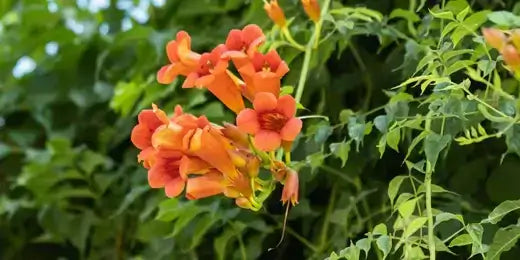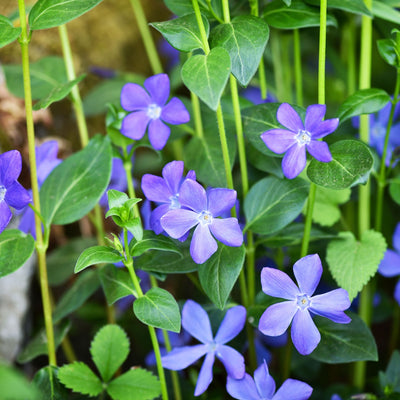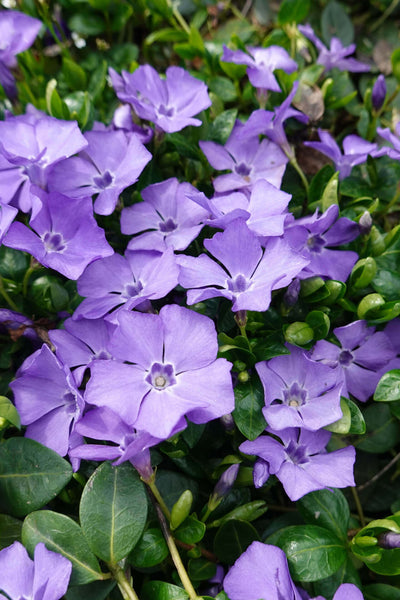Growing Vining Plants: Their Types, Care, and Growing Tips
Like any other type of plants grown in a garden, vining plants come in handy in adding beauty and color to a garden; however, like any other type of plants, they come with their challenges too and require a bit of effort to grow. This article covers and answers all vining plants types, their care, and how you can help them grow to their optimal. Worry not, the common questions regarding vining plants will also be answered in the article below!
Types of Vining Plants
There are several types of vining plants. All these plants differ, in terms of requirements and aesthetics, and they also differ in their mode of growth. Let’s take a look at the most common vining plants below:
Twining Vines
An example of a twining vine is the Morning Glory and Honeysuckle, which are able to unwind their stems and surround any kind of support structure. Twining vines are well suited for things like fences, trellises, and arbors. These frameworks are well suited for these plants, as they require some type of support to be able to grow. These types of vining plants are commonly chosen, as they grow at a fast rate and can cover structures within a short period of time.
Tendril Vines
Tendril vines cling and wrap around objects like clematis, passionflower, and grape vines using tendrils. They like tendril vines best on structures that are narrow like string or wire. They are ideal for chain-link fences, but if you'd prefer them to grow on a solid fence, be prepared to add some supports. Sweet violets are also good ground-cover plants and belong to this group.
Clinging Vines
Both wisteria and winter creeper are clinging vines capable of sticking to fences and walls. They are able to do this because of rootlets that are specially designed to cling onto surfaces. Clinging Vines tend to be very harmful to walls as well, especially to weak walls. Walls that are weakly constructed are more easily damaged and therefore more sensitive to the plants. This is why their growth should be monitored closely.
Ground-Cover Vines
Ground-cover vines are plants that are able to cover the ground. An example of a ground-cover vine is Vinca minor (periwinkle or creeping myrtle). These specific plants tend to lose to weeds very easily. Wild Geranium is also a stunning plant.
Ground-cover vines as a whole do not twine and do not climb, but are the best for covering empty spaces that are not directly exposed to the sun. Vinca minor is especially well known for the blue flowers that she possesses, but if not controlled, she can be very bothersome.
Weeds: English Ivy
Weeds are difficult to control and English ivy is one of the worst. There is hardly any vertical structure ivy cannot climb. It is indeed lovely to view and add to the footpath. Not to mention, it grows along the ground, all of which is ivy and each one a lovely addition to the garden, but you, if you ain’t careful, English ivy weeds would altogether cover the garden. Further, it is a soft fruit that sits on the top of a green bush. Animals are attracted to it for the berries, but they are in some cases, harmful to the human body if taken. Again, all invasive vines need to be sheered on a regular basis to avoid running riot.
Important Things to Keep in Mind When Growing and Maintaining Vines
The plants are often very delicate and include a weft of vines. Each one adds to it and with time they grow long and flourish. Like anything else, the work put in is well worth it. There are a few straggling pointers that can be put in place to help you along the way.
Placement of the Vine
The sort of climate which is in the vicinity impacts the plants as well. There are various different species, with varied requirements and needs. Check the vine you wish to plant on the plant deep freeze map to have a rough idea. Also, some plants enjoy having a good amount of sun on them, while others only wish to be in the shade. Make sure you offer the appropriate spot for the plant for its needs.
Support Vines as Needed
Vines are capable of climbing but need specific support. There are twinning vines that require poles or boards such as those used in pergolas. For various tendril vines, string or wire works fine. Clinging vines that grow against solid vertical structures, such as walls or clinging structures, are capable of self-attachment. Take, for instance, Vinca minor or English Ivy, though excellent for ground cover, are highly invasive, thus, maintenance becomes a necessity.
Soil and Watering Requirements
Most vining plants are very soil tolerant but grow best in rich, well-drained soil. To see if soil is good enough for that plant, one must exercise a shovel and see if there are any worms in that soil. Plants have different watering needs, but most vines are drought-tolerant once established well. Vines, of course, that are very newly established, must be regularly watered until they are rooted and established.
Pruning and Maintenance
Pruning helps to keep the vines occupied within certain boundaries, which is important for the health of the plant. In addition, the removal of dead or diseased branches will also assist in promoting better growth. Other vines of greater concern, such as climbing vines, can cause harm to your dwelling and other structures, which is why monitoring them is important.
Conclusion: Get Those Vining Plants In The Ground!
Vining plants are stunning and are a great addition to any garden. There are different types of mile-a-minute and purple wisteria vines which are great if you are after some color.
On the other hand, there are other types which can help to cover up. If you want some natural privacy, there are other vines that do the job as well. Vines can be an incredible addition to your garden if taken care of properly, visit TN Nursery to shop vining plants.
FAQs about Vining Plants
The answers to some common questions may assist you with the selection and growing of your vining plants to a certain extent.
What are the best vining plants?
Depending on the requirements of your garden as well as the climate, some of the best vining plants include the morning glory, honeysuckle, clematis, and passion flower for their beauty and vigorous growth. Also, if groundcover is something you’re looking for, Vinca minor is an excellent choice. Finally, there is English Ivy which offers a classic, traditional look while also being a bit more appealing to the faster growers.
What is the fastest growing climbing plant?
Morning glories are the fastest growing climbing plants. These vines can fill in entire trellises as well as fences in a season and are available in a dazzling array of blues, purples, and pinks. Morning glories can grow ten feet in a season, making the covering of wide open space a simple and quick task.
What are vine plants called?
A vine plant is categorized as a "climber" and is defined as a plant that ascends, and or spreads over a surface in a specific manner. A climber plant uses twining, which is wrapping around an object, as well as tendrils, which are arms that reach up and attach themselves to a support, and other forms that support the surface like aerial roots. Climbers can be found in flowering and non-flowering plants and are able to serve as ground cover or climbing plants.
What is the vine plant that spreads?
An example of a spreading vine plant is Vinca minor, periwinkle, or creeping myrtle. These types of vines differ from climbing vines and instead, spread along the ground. These types of plants sprawl over weeds, assisting in the elimination of them. While the plant is beautiful, if left uncontrolled it can be very invasive, so be sure to contain it.
Are there pure vines that flower all summer?
Of course! The most popular summer blooming clematis vines are known for their brilliant and vibrant colors. Their flowers come in different colors and in many different shapes, which is primarily why gardeners enjoy their clematis. Bloom for all summer long, clematis vines do exceptionally well in the full sun. They are a splendid addition to any garden and thrive on interest and color. They will bloom for multiple months, adding to the beauty of the garden.
Is there a difference in cost when you build versus buy a trellis?
If you have some materials at home, like some wood from an old bed and some wire, building a trellis can be cheaper. On the other hand, if you are after a specifically designed trellis, buying one from a store will save you time and effort. In the end, it really is your decision based on your preference or based off the effort you wish to invest to build the trellis.





